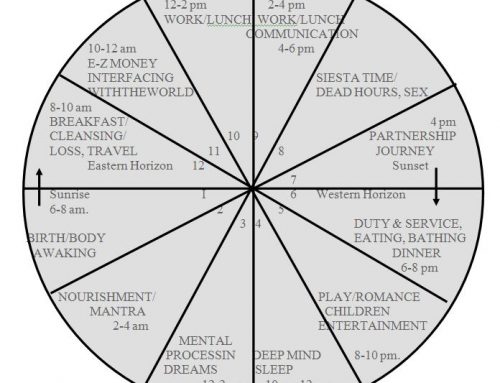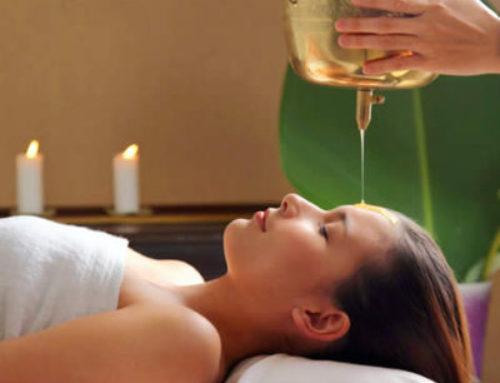In the Vedic science of Vāstu Śāstra, structures are aligned to optimize the longevity and success of the people who dwell in them, whether they be temples, homes or businesses, and to promote the integrity of the structures themselves. By practicing yoga, we too seek to improve our vastu– the proper alignment of our bodies, which are the dwelling places of the soul. In this article we will explore how to apply specific Vāstu Śāstra techniques to make our yoga practice perfect.
Just like a sagging roof devalues a house, so poor posture diminishes you in the eyes of the world. Rounded shoulders and a kyphotic curve (upper cross syndrome) and a lordodic spine with anterior pelvic tilt (lower cross syndrome) are the two most common postural defects today. Working with computers and cell phones contribute to the former, and hours of sitting to the latter. Perhaps this is why the science of yoga has come to the West. Poses like bridge and wheel help to fire up and activate the ‘rear-wheel drive’ of our bodies- the structural and functional muscles of the back and legs, which get turned off by excessive sitting. Likewise, cobra, plank, and triangle help to counter upper cross syndrome by encouraging a neutral spine. But this is just the beginning. Good posture is not just a physical attitude, but a mental as well as spiritual orientation.
In his book Vastu, Breathing Life into Space,[i] dr. Robert Svoboda writes that orientation, which means “the act of facing east” is a literal as well as figurative attitude. To ‘orient yourself’ means to face the sunrise, to align yourself with the movement of the heavens. We do this everyday when we practice sun salutation or sit for meditation. Good vāstu also dictates this at night- going to sleep with our heads to the west, so that we awake automatically facing east. [1] Before we leave the house, through our (optimally) East-facing door, we also ‘get off on the right foot’ by literally stepping with the foot that correlates to the astrological weekday. To be even more “astrologically correct” we should have the same nostril open as the foot we’re using to step out of the door:
Sunday- right foot, right nostril open
Monday- left foot, left nostril open
Tuesday- right foot, right nostril open
Wednesday- left foot, left nostril open
Thursday- left foot, left nostril open
Friday- left foot, left nostril open
Saturday- right foot, right nostril open
The breath often indicates how our plans for the day turn out- the placement of the foot relates to how we feel about that outcome. When both are aligned and proper for the day, we encourage optimal and satisfying outcomes.
Life is Ritual
This is a simple ritual from Vāstu and Vedic Astrology that helps us get the most from our day by bringing awareness and meditation to our activities. Studies show that rituals like saying grace before we eat can have profound effects on our bodies and minds. In a Harvard experiment [2], participants ate more slowly and reported their food tasted better when it was preceded by a ritual. In addition, they attached greater value to their meal, and were willing to pay more money for it. This would come as no surprise to the sages of ancient India who who cognized the study of Vāstu and Āyurveda. Indeed, they would add that eating more slowly and deliberately also leads to better digestion, absorption and elimination, which in turn translate into better health, longevity… and happiness. That is why Āyurveda recommends that we make our midday meal the largest, and take plenty of time to eat our food without distractions like TV, and follow it by lying (or leaning) on our left side for ten to fifteen minutes.
All of life can be a ritual. Ninety percent of the thoughts we have today, we had yesterday. We recycle the same actions, thoughts and worries day in and day out, everyday of our lives. The sages of ancient India sought to ritualize these activities, to bring awareness and value into their practice. One of the ways to do this is to align yourself with the movement of the planet by facing the rising sun each day and saying a little prayer- whatever your spiritual tradition. Another is to bring awareness to your meals. Yet another is to bring awareness and proper posture to your elimination. Consider going to the toilet an active extension of your yoga practice, rather than a passive event you do while sitting on the can.
For thousands of years, humans have squatted to eliminate. Only in the last century have we begun to sit- and this has led to an explosion of colo-rectal problems, from hemorrhoids to colitis. Luckily, modern inventions like the Apana Stool (www.apanastool.com) also help to alleviate the problems caused by modern toilets by properly orienting us for elimination. These devices fit easily in our bathrooms and are yet another way to bring ritual into our lives, as well as continued practice of that most natural of hip-opening postures, the squat.
By following practices like this, we inject awareness into our activities, linking our lives below to the movement of the heavens above, which is the true meaning of Yoga. ,
[1] Sleeping with the head to the south is also fine, as is the head to the east if you are a student or spiritual practitioner, but sleeping with the head to the north leads to depression, anxiety and confusion, according to Vastu Shastra and its sister science Ayurveda.
[2] http://www.psychologicalscience.org/index.php/news/releases/to-savor-the-flavor-perform-a-short-ritual-first.html
[i] Vastu, Breathing Life into Space by Dr. Robert Svoboda. Published by Namarupa, 2013.






